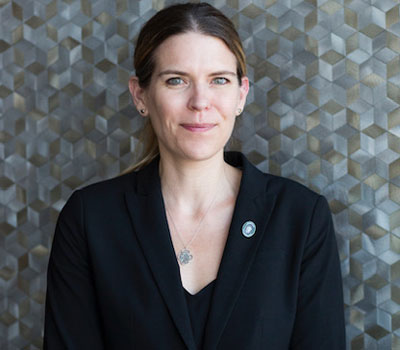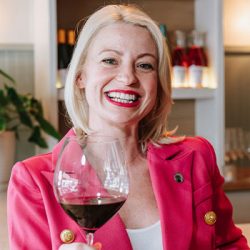Catherine Morel has been running the wine program since this destination restaurant’s opening—on the 71st floor of the U.S. Bank Tower in downtown LA—nearly eight years ago. She has recently changed titles from Wine Director to Beverage Director though that title still doesn’t reflect all of the various hats she wears—in management, scheduling, front-of-house staffing, overseeing the reservation books, social media, menus. She even keeps a matrix for staff with ingredient lists for allergy tracking. Morel concedes that Beverage Director “is a little more reflective of what I do and, after all, there are other things to drink than wine.” —Patrick J. Comiskey


How did you get into wine?
I was actually a day bartender at a restaurant for a while when I was really young. That’s when the wine reps would come in, during the afternoons, to meet the buyer. So I got to try a lot of stuff. Naturally I went in that direction because I was surrounded by it…it wasn’t a single bottle where I said, ‘Oh my god, I love wine.’
What are the wine categories that interest you right now?
It shifts. Right now the wine regions of the future are really interesting to me, I’m looking around and paying attention to what’s going on in Tasmania, what is or what will be going on in England. I’m impressed with the sparkling wines, like Ridgeview and Chapel Down, and Pressing Matters in Tas—I had a great riesling from the Coal River Valley there. I’m not necessarily buying a lot of stuff yet from those places, but I still think it’s interesting how we’re already making adaptations because of climate change, and there will be so many possibilities in the future; it’s going to change what will be interesting to drink. I’m really interested in watching that change.
We get a lot of wine groups coming in for group dinners, Burgundy and Bordeaux lovers and I’m wondering what’s going to happen to them when Bordeaux is no longer made from cabernet sauvignon and merlot, and it’s [made from] these other obscure grapes.
I’m always interested in what’s going on in California because I live here and I know the winemakers and the regions and really love watching the future happen here. I got to drive my first Ford F1 Lightning, Ford’s electric truck—they’re being used at Dutton Ranch now and cutting into their carbon footprint.
What categories do you focus on most for the restaurant?
Old wine, white wine, whatever’s hot in California right now, and cabernet. We do a lot of wine pairings here, and so I focus on having a variety of interesting whites that can be food friendly. I make sure to have white wines for all of our wine pairings. It’s almost always whites because chef’s food is just not crazy heavy—outside of the ribeye. We use white wine for almost everything. I think I only have two reds right now, in the second course.
As for California, we’re a tourist destination, and of course they want to drink California wine because they’re in California.
On buying old wine
Our wine list got huge this year: We’ve added 1,200 labels, most of them older bottles. We put a big focus on old wine. Don’t ask me how I’m managing the storage.
We sell tons of old Rioja. It holds up really well, and it isn’t priced like old Burgundy or Bordeaux. I think we have five pages of old Rioja, a bunch of old Italians. Old stuff generally is interesting, and still affordable if it’s not Burgundy or Bordeaux. 1928 Bodegas Age Crianza Rioja ‘Saco’ on the list, still in its burlap sack. The owner of the restaurant is so fun to work with, especially when we get to go shopping. We go back to the ’50s for Barolo; we have some old Borgogno going back to 1931.
It’s so exciting to open them and see how much they’ve changed, what’s alive and what’s interesting. And what’s really fun is to see people experience old wines for the first time.
Has wine’s share of your total beverage sales increased or decreased over the past year?
It’s decreased. There’s really been an overall decrease in wine consumption, and an increase in cocktails and booze and liquor. Even large tables; we used to line up wines for large parties but instead with got, like, 30 people together and everyone was drinking cocktails.
Why?
Some of it’s price. Most spirits are less expensive than, say, California cab; you can have two cocktails each for 40 bucks, and get the same buzz as a $120 bottle of wine. That changes when money anxiety goes away but for now inflation is keeping this steady. Personally, I don’t get it: some cocktails pair beautifully with food but…it’s not the same thing, no matter how hard you try.
What’s trending?
California cabernet; but also a bit more cabernet franc. Chinon does surprisingly well. I’m selling a lot of Domaine Dozon Chinon Clos du Saut au Loup. And then the California wines—Darioush, Chappellet—I’ve reordered those more than other things. Younger Spanish stuff. But aside from California wines, our clientele is too across-the-board for trends to really happen here. And I’ve never been able to predict anything; it drives me crazy.
What’s wine’s role in the future?
I think there will be a shift back toward wine. During the pandemic all the spirits took over social media, with influencers and with all the celebrities going, ‘Oh, drink my brand, it’s really pure,’ or whatever the crap they were saying. But every time the Surgeon General pushes back on liquor, people swing back to wine. And spirits are getting ridiculously expensive as well. So I think the mid-point will come back—Rhône, Loire, Spanish. You aren’t going to drop $300 on a bottle of wine if you’re in your twenties, unless you’ve got a trust fund.
Patrick J. Comiskey covers US wines for Wine & Spirits magazine, focusing on the Pacific Northwest, California’s Central Coast and New York’s Finger Lakes.
This is a W&S web exclusive. Get access to all of our feature stories by signing up today.



















